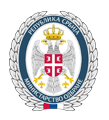- About MoD
Minister and Associates
- Minister
- State Secretary
- Assistant Ministers
- Secretary of the Ministry of Defence
Sectors
- Defence Policy Sector
- Human Resources Sector
- Material Resources Sector
- Budget and Finanance Sector
- Sector for Infrastructure and Hospitality Services
- SAF
- Documents
- Services
- Sport
- Archive
- Contacts
31.03.2016.
Exhibition "The Serbian Orthodox Church and the Russian emigration (1920-1940)" opens
 In the Conference Hall of the Central Military Club, an exhibition "Serbian Orthodox Church and the Russian Emigration (1920-1940)", which is a collaborative effort between the Archives of the Serbian Orthodox Church and the Odbrana Media Centre has been opened today. The opening was attended by His Holiness Serbian Patriarch Irinej, State Secretary in the Ministry of Defence Nenead Neric, Russian Ambassador Alexander Chepurin as well as numerous guests.
In the Conference Hall of the Central Military Club, an exhibition "Serbian Orthodox Church and the Russian Emigration (1920-1940)", which is a collaborative effort between the Archives of the Serbian Orthodox Church and the Odbrana Media Centre has been opened today. The opening was attended by His Holiness Serbian Patriarch Irinej, State Secretary in the Ministry of Defence Nenead Neric, Russian Ambassador Alexander Chepurin as well as numerous guests.Speaking about relations between the two nations, director of Odbrana Media Centre Colonel Stevica S. Karapandzin stressed that the Russians have always helped Serbia, especially during the Great War, reminding that after the Austro-Hungarian attack on Serbia, the Russian tsar ordered, on 31 July, the mobilization of the army, which raised the level of the war to the European and then the world level.
He pointed out that Serbia got the opportunity to return the help to the brotherly people a few years later, when, after the revolution, over ten million Russians found themselves outside the borders of Russia.

- The former elite of the Russian people were offered fraternal hand by King Aleksandar Karadjordjevic and the Serbian people. On the other hand, the immeasurable potential of the Russian emigration between the two wars made a positive impact in Serbia in all fields – science, art, culture, architecture, medicine, industry, transport and defence, Colonel Karapandzin said.
Radovan Pilipovic, director of the Archives of the Serbian Orthodox Church and the author of the exhibition, pointed out that the Revolution of 1917 led to changes in social and political system in Russia, which forced many Russians to leave their country. Some of them, he said, permanently settled in the former Yugoslavia.
 - According to the official statistics, and reliable administrative data, in 1929, in the Serbian Orthodox Church, among 2,924 active parish priests there were 214 Russians, Pilipovic said, noting that they were important for the class of priests which was decimated in our region during the earlier years of war.
- According to the official statistics, and reliable administrative data, in 1929, in the Serbian Orthodox Church, among 2,924 active parish priests there were 214 Russians, Pilipovic said, noting that they were important for the class of priests which was decimated in our region during the earlier years of war.Opening the exhibition, His Holiness Serbian Patriarch Irinej said that the exhibition presents the historical and cultural truth of the relations between the Serbian and the Russian peoples. He recalled that the cultural, historical, religious and spiritual ties between the two nations have always been strong, noting that the Russians have left a deep mark in the Serbian history and culture, because their professors, priests, artists and scholars after the revolution in Russia arrived in Serbia and occupied important positions in the cultural and public life of our country.
- Our Church was deprived of many priests, and only in the Nis region, at Toplica, more than 150 priests were killed. That eparchy was almost empty after the First World War, and that void was filled by many Russian priests, said the Patriarch, stressing that we must never forget the fraternal ties between the two nations who share the same faith.

The archival exhibition consists of 121 pieces (documents, photos, posters, flyers and newspapers). The exhibition is dedicated to the 80th anniversary of the death of the great Russian hierarch, Metropolitan of Kiev and Gallich and president of the Russian Orthodox Church Outside Russia Anthony Khrapovitsky.
Russian emigration in the Balkans is a historical phenomenon that in recent decades has increasingly attracted the attention of historians. Although the works on this topic are numerous, many of which are characterized by quality and research results, the unused archival sources again and again shed light on certain aspects. It was the case with material from the Archives of the Serbian Orthodox Church, which is almost unknown to the researchers and scholars studying the past.
Opening of the exhibition was added solemnity by performance of the First Belgrade Singing Society and the church children's choir "Orlici".
The exhibition will be open in the Small Gallery until 16 April.
 PHOTOGALLERY
PHOTOGALLERY VIDEOGALLERY
VIDEOGALLERY- About MoD
- Jurisdiction
- Organisation scheme
- Description of duties
- Minister and Associates
- Minister
- State Secretary
- Assistant Ministers
- Secretary of the Ministry of Defence
- Sectors
- Defence Policy Sector
- Human Resources Sector
- Material Resources Sector
- Budget and Finanance Sector
- Sector for Infrastructure and Hospitality Services
- Special Internal Units
- Secretariat
- Office of the Minister of Defence
- Military Attorney's Office
- Administrative Bodies within MoD
- Defence Inspectorate
- Military Intelligence Agency
- Military Security Agency
- Autonomous Departments
- Public Relations Department
- Military Healthcare Department
- Higher Education Institution
- Defence University
- Specific internal units
- Inspector General of the Services
- Internal Audit Section
- SAF
- Documents
- Services
- Sport
- Archive
- Contacts






